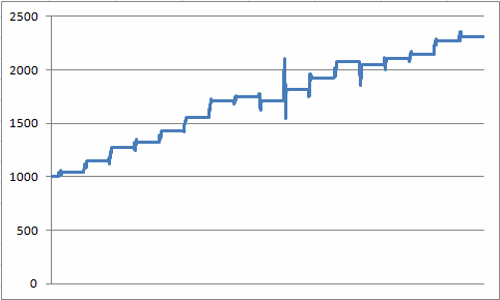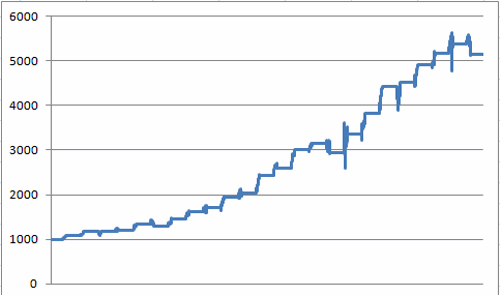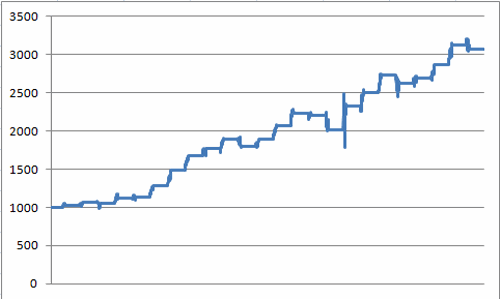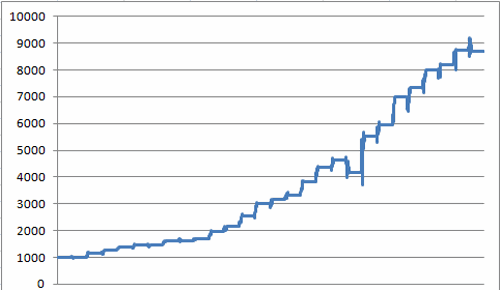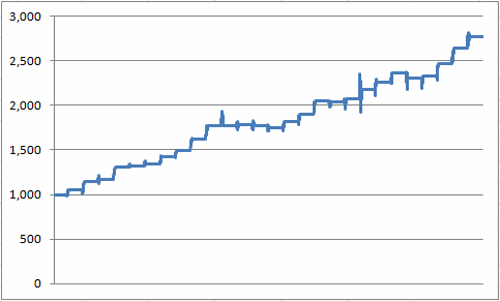A while back I wrote an article about a hypothetical bearish position using options on ticker USO – an ETF that (purports to) track the price of crude oil. Long story short, it didn’t work out. USO rallied and the position that had downside profit potential and a maximum risk of -$2,650 was theoretically stopped out when resistance was broken for a loss of roughly -$680.
See also We Are Living in a Material(s) World – Part 2
And now I am looking at another bearish position in USO. Whoa, is that a good idea? I mean the last bearish trade didn’t work out, so why risk throwing good money after bad? For one simple reason: one trade – any trade – has absolutely nothing to do with any other trade. If one’s analysis suggests that a bearish position in a particular stock, index, commodity, etc., is in order, then a bearish position is in order – regardless of what happened “last time”, or the time before that.
Seasonality in Crude Oil
Figure 1 displays the annual seasonal chart for spot crude oil since oil futures started trading in 1983. Anything jump out at you? Figure 1 – Annual Seasonal trend for crude oil
Figure 1 – Annual Seasonal trend for crude oil
As you can see in Figure 1, the period between October trading day #10 and December trading day #8 has tended to by an “unhappy time” for people holding a long position in the slick stuff.
Figure 2 displays the gain or loss a trader might have experienced by holding a long position in crude oil futures during our unfavorable seasonal period going back to 1983. Figure 2 – $ +(-) holding a long position in crude oil futures from October Trading Day #10 through December Trading Day #8; 1983-present
Figure 2 – $ +(-) holding a long position in crude oil futures from October Trading Day #10 through December Trading Day #8; 1983-present
For the record:
*Up 8 times (25%)
*Down 24 times (75%)
*Average gain = +$3,859
*Average loss = (-$6,165)
*Largest up moves = +$10,700 (2007) and +$10,600 (2012)
*Largest down moves = -$35,100 (2008) and -$21,050 (2014)
The 10th trading day of October was October 14, 2016. So far crude oil futures and ticker USO are roughly unchanged. The most direct way to play would be to sell short crude oil futures. But at $1,000 a point – and given the maximum up and down moves listed above – crude oil futures are absolutely in the “high risk/high reward” category and not appropriate for most traders. In order to limit our risk we will look instead at put options on ticker USO.
USO Options, Implied Volatility and Time Premium
Figure 3 displays the price action for USO over five years and the changes in the implied volatility (the black line) for options on USO. Low IV tells us that there is relatively little time premium built into the price of the options while high IV tells us that there is a lot of premium built into the price of the options. This matters because “time decay” causes all options to lose their entire time premium by expiration. Figure 3 – USO price and implied volatility (IV) history
Figure 3 – USO price and implied volatility (IV) history
As you can see in Figure 3, presently the implied volatility for USO options is essentially in the middle of the 5 year historical range. Therefore we could see a large increase OR a large decline in implied volatility (or no change at all). In other words, it is essentially a coin flip to predict what will happen next in implied volatility for USO options. Based on a bearish outlook for price and no outlook whatsoever for IV we are going to look at a strategy that mitigates the effect of time decay.
One way to mitigate time decay is to write options. However, the time to do that is when IV is extremely high. As we saw in Figure 3 it is presently neither high nor low. So we will look to buy options. If you want to limit the risk of time decay when buying options the best approach is simply not to pay very much to begin with. So for this example we will use a strategy known as “buying a deep-in the-money” put option. This simply means that we will buy a put option with a strike price well above the current price of the underlying security.
The Trade
For this example our trade is as follow:
Buy 12 USO Dec 13 puts @ $1.70
December options are the first series that we can hold through (i.e., they do not expire prior to) December trading day #8. As you can see in Figure 4 below, the 13 strike price has a relatively tight bid/ask spread of $1.67 bid/$1.70 ask and there is also some volume at this strike – as opposed to some of the higher strikes. Figure 4 – USO December put options (Courtesy www.OptionsAnalysis.com)
Figure 4 – USO December put options (Courtesy www.OptionsAnalysis.com)
The particulars for this trade appear in Figure 5 and the risk curves in Figure 6 Figure 5 – Long 12 USO Dec13 puts (Courtesy www.OptionsAnalysis.com)
Figure 5 – Long 12 USO Dec13 puts (Courtesy www.OptionsAnalysis.com)
Note that as this is written, USO is trading at $11.43 a share. Note also in Figure 5 that the breakeven price for this trade is $11.30 a share. This is arrived at using the following formula: (Option strike price – option premium), or ($13 – $1.70) = $11.30.
So once USO falls -1.1% – from $11.43 to $11.30 – then below that price the option will move point-for-point with the shares (see Figure 6). Figure 6 – Risk curves for Long 12 USO Dec13 puts (Courtesy www.OptionsAnalysis.com)
Figure 6 – Risk curves for Long 12 USO Dec13 puts (Courtesy www.OptionsAnalysis.com)
There is no “set in stone” stop-loss point for this trade. If a trader is willing to risk the full $2,040 he or she can simply “let it ride” if USO starts to move higher knowing that the maximum risk is limited to that amount. Other traders might consider a stop-loss point somewhere above the recent resistance level $12.45 a share for USO.
Summary
This trade has:
*Limited risk
*A close breakeven point
*An obvious resistance level above that might be used as a stop-loss point, and;
*The potential to make money if USO falls even a little bit in the weeks ahead.
All that being said, as always, trades presented here are “examples” and NOT “recommendations”. As I noted at the outset, I have been wrong before on crude oil. The example shown here simply constitutes a “soup to nuts” lesson in one way to play a potential decline in the price of crude oil.
Jay Kaeppel
